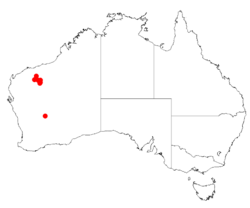Biology:Acacia effusa
| Acacia effusa | |
|---|---|
| Scientific classification | |
| Kingdom: | Plantae |
| Clade: | Tracheophytes |
| Clade: | Angiosperms |
| Clade: | Eudicots |
| Clade: | Rosids |
| Order: | Fabales |
| Family: | Fabaceae |
| Subfamily: | Caesalpinioideae |
| Clade: | Mimosoid clade |
| Genus: | Acacia |
| Species: | A. effusa
|
| Binomial name | |
| Acacia effusa Maslin
| |

| |
| Occurrence data from AVH | |
Acacia effusa is a shrub belonging to the genus Acacia and the subgenus Juliflorae that is endemic to north western Australia .
Description
The shrub is dense and spreading typically grows to a height of 0.3 to 1 metre (1 to 3 ft).[1] It has grey to grey-red coloured minni ritchi style bark that peels backward in small rolls. The terete branchlets are matted with dense wolly hairs but become more glabrous as they mature. Like most species of Acacia it has phyllodes rather than true leaves. The evergreen phyllodes are ascending and have an obliquely oblong-elliptic to narrowly elliptic shape with a length of 0.6 to 1.5 cm (0.24 to 0.59 in) and a width of 2 to 7 mm (0.079 to 0.276 in) with a mid-nerve that is quite prominent.[2] It blooms from May to August producing yellow flowers.[1]
Taxonomy
The species was first formally described by the botanist Bruce Maslin in 1982 as part of the work Studies in the genus Acacia (Leguminosae: Mimosoideae). Acacia species of the Hamersley Range area, Western Australia as published in the journal Nuytsia. It was reclassified as Racosperma effusum by Leslie Pedley in 2003 then transferred back to genus Acacia in 2006.[3]
Distribution
It is native to an area in the Pilbara region of Western Australia where it is often situated on scree slopes of low ranges growing in stony red loamy soils.[1] It has a limited range mostly within the Hamersley Range National Park where it is considered to be abundant on the lower slopes where the watercourses exit the range.[2]
See also
References
- ↑ 1.0 1.1 1.2 "Acacia effusa". FloraBase. Western Australian Government Department of Parks and Wildlife. https://florabase.dpaw.wa.gov.au/browse/profile/3316.
- ↑ 2.0 2.1 "Acacia effusa". WorldWideWattle. Western Australian Herbarium. http://worldwidewattle.com/speciesgallery/effusa.php. Retrieved 16 April 2020.
- ↑ "Acacia effusa Maslin". Atlas of Living Australia. Global Biodiversity Information Facility. https://bie.ala.org.au/species/https://id.biodiversity.org.au/node/apni/2907871#names. Retrieved 16 April 2020.
Wikidata ☰ Q9564381 entry
 |


